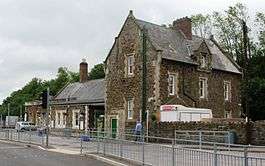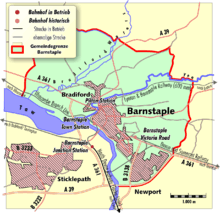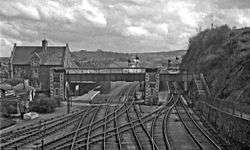Barnstaple railway station
| Barnstaple | |
|---|---|
 | |
| Location | |
| Place | Barnstaple |
| Local authority | North Devon, Devon |
| Coordinates | 51°04′26″N 4°03′47″W / 51.074°N 4.063°WCoordinates: 51°04′26″N 4°03′47″W / 51.074°N 4.063°W |
| Grid reference | SS555325 |
| Operations | |
| Station code | BNP |
| Managed by | Great Western Railway |
| Number of platforms | 1 |
| DfT category | E |
|
Live arrivals/departures, station information and onward connections from National Rail Enquiries | |
| Annual rail passenger usage* | |
| 2010/11 |
|
| 2011/12 |
|
| 2012/13 |
|
| 2013/14 |
|
| 2014/15 |
|
| History | |
| Original company | North Devon Railway |
| Pre-grouping | London and South Western Railway |
| Post-grouping | Southern Railway |
| 1854 | Opened |
| 1874 | Renamed 'Barnstaple Junction' |
| 1970 | Reverted to 'Barnstaple' |
| National Rail – UK railway stations | |
| * Annual estimated passenger usage based on sales of tickets in stated financial year(s) which end or originate at Barnstaple from Office of Rail and Road statistics. Methodology may vary year on year. | |
|
| |
Barnstaple railway station is the terminus of a long branch line, known as the Tarka Line, 39 miles (63 km) north west of Exeter St Davids, in Devon, England.
It was known as Barnstaple Junction from 1874 to 1970 as it was the junction between lines to Ilfracombe, Bideford, Taunton and Exeter.
History

- Black lines: in use
- Grey lines: closed and lifted
A railway for goods traffic was operated from Fremington Quay, opening in August 1848. On 1 August 1854 the North Devon Railway opened from Barnstaple to Crediton. Trains were extended via Fremington to Bideford on 2 November 1855. This route was eventually extended to loop back to Okehampton via Torrington and Halwill Junction.[1] The North Devon Railway was amalgamated into the London and South Western Railway on 1 January 1865.
The station became known as Barnstaple Junction on 20 July 1874 when the railway opened the Ilfracombe branch line. The line crossed the river on a large bridge to a station at Barnstaple Quay which in turn was replaced by Barnstaple Town on an adjacent site in 1898 when the narrow gauge Lynton and Barnstaple Railway was opened. This station is now a smart school.
On 1 June 1887 a loop line was laid to connect the station with the Devon and Somerset Railway, later taken over by the Great Western Railway, which had opened its own Barnstaple station at Victoria Road as the terminus of the line from Taunton on 1 November 1873.

The Junction station was extended in 1874 for the Ilfracombe services and again in 1924. The first services to be withdrawn were the passenger trains to Bideford on 2 October 1965. Passenger services had been transferred from Victoria Road in January 1960 and the line to Taunton closed on 3 October 1966. Victoria Road remained open for goods traffic, accessed via the loop line from Barnstaple Junction, until 5 March 1970, when it closed entirely. The line to Ilfracombe was closed later that year, on 5 October, and so the station became plain Barnstaple once more.
On 21 May 1971 the track was simplified and the line to Umberleigh was reduced to just one track. A new booking office was opened on 10 November 1981 but goods trains beyond on the Fremington line were withdrawn on 31 August 1982 leaving the station as a terminus.
In 2006 the bridge that carried Sticklepath Hill (the A3125) across the former Bideford and Ilfracombe lines was demolished to make way for a road junction for the Barnstaple Western Bypass, which opened in May 2007. The roundabout here has been built on a raised platform in order to allow for the reopening of the line to Bideford should this be proved viable in the future. Work from the bypass has also included a larger station car park and better bus access – a large number of Barnstaple town services, as well as services to Bideford, Ilfracombe and South Molton now call at the station.
During the year ended March 2009, passengers using Barnstaple station exceeded ¼ million for the first time.
In 2009 the Association of Train Operating Companies included the Barnstaple to Bideford route in its Connecting Communities: Expanding Access to the Rail Network.[2] This recommended some closed lines ought to be rebuilt to restore a railway service to large communities.[3] This same line was rebuilt for one day that same year using OO gauge track in a television project orchestrated by presenter James May, in attempt to build the longest ever model railway. Although the track was restored between the two towns the model railway trains were only able to reach the site of Instow signalbox before failing.[4] May stated that he chose the location for the attempt due to his desire to see the line restored.[5]
May repeated this experiment in 2011, using Hornby R603 rails laid as double track by a mechanical track layer. A competition saw a British team, led by May, racing three trains from Barnstaple to Bideford, against a German team running the route in the opposite direction.[6] All six trains completed the 10-mile run, with the British team claiming a 2:1 victory.
Motive power depot
The North Devon Railway opened a motive power depot at the station in 1854. A larger building was erected alongside in 1864 by the London and South Western Railway. This building was re-roofed by the Southern Railway in the 1940s, but closed by British Railways in 1964 and demolished.[7]
Station Cafe
The cafe at Barnstaple station was opened in 2008 by Mike Day in one of the 'closed' areas of the station building, and it appeared in a list of the ten best station cafes published in The Guardian just one year later.[8]
Description
The single platform is on the east (right) of trains arriving from Exeter. There is level access to the station car park. The centre of Barnstaple is reached by crossing the Long Bridge over the River Taw 330 yards (300 m) from the station.
A footpath from the station leads onto the cycleway along the abandoned railway line to Bideford which forms part of the South West Coast Path.
Services
Barnstaple is served by fifteen trains each weekday (approximately once each hour) and seven on Sundays (once every two hours) in the May 2013 timetable.[9] Most services run to Exmouth, passing through Exeter St Davids railway station where connections with main line services are available. Services are usually provided (in 2015) by Class 143 "Pacers", and Class 153 and 150 "Sprinters".
| Preceding station | |
Following station | ||
|---|---|---|---|---|
| Chapelton | Great Western Railway Tarka Line |
Terminus | ||
| Disused railways | ||||
| Barnstaple Victoria Road Line and station closed |
Great Western Railway Devon and Somerset Railway |
Terminus | ||
| Barnstaple Town Line and station closed |
London & South Western Railway Ilfracombe Branch Line |
Terminus | ||
| Chapelton Line and station open |
London & South Western Railway North Devon Railway |
Fremington Line and station closed | ||
Community railway
The railway between Exeter and Barnstaple is designated as a community railway and is supported by marketing provided by the Devon and Cornwall Rail Partnership. The line is promoted under the "Tarka Line" name.
Three pubs at Barnstaple are included in the Tarka Line rail ale trail.
References
| Wikimedia Commons has media related to Barnstaple railway station. |
- ↑ Nicholas, John, The North Devon Line, Oxford Publishing Company 1992, ISBN 0-86093-461-6
- ↑ "Connecting Communities - expanding access to the rail network" (PDF). London: Association of Train Operating Companies. June 2009. p. 16. Archived from the original (pdf) on 29 July 2013. Retrieved 20 February 2015.
- ↑ ATOC 2009, p. 9.
- ↑ James May's Toy Stories, Hornby
- ↑ "Top Gear's James May sees model railway world record attempt derailed by thieves". The Daily Telegraph. London. 25 August 2009. Retrieved 26 April 2010.
- ↑ James May's Great Train Race: Tarka Trail 2 Archived July 23, 2011, at the Wayback Machine.
- ↑ Roger Griffiths & Paul Smith, Directory of British engine sheds: 1, (OXford: OPC, 1999), p.30.
- ↑ Wills, Dixe (2009-05-12). "Ten of the best railway cafes". London: Guardian. Archived from the original on 15 May 2009. Retrieved 2009-06-30.
- ↑ "National Rail Timetable 136 (May 2013)" (PDF).
| This station offers access to the South West Coast Path | |
|---|---|
| Distance to path | 50 yards (46 m) |
| Next station anticlockwise | Newquay 123 miles (198 km) |
| Next station clockwise | Minehead 69 miles (111 km) |
